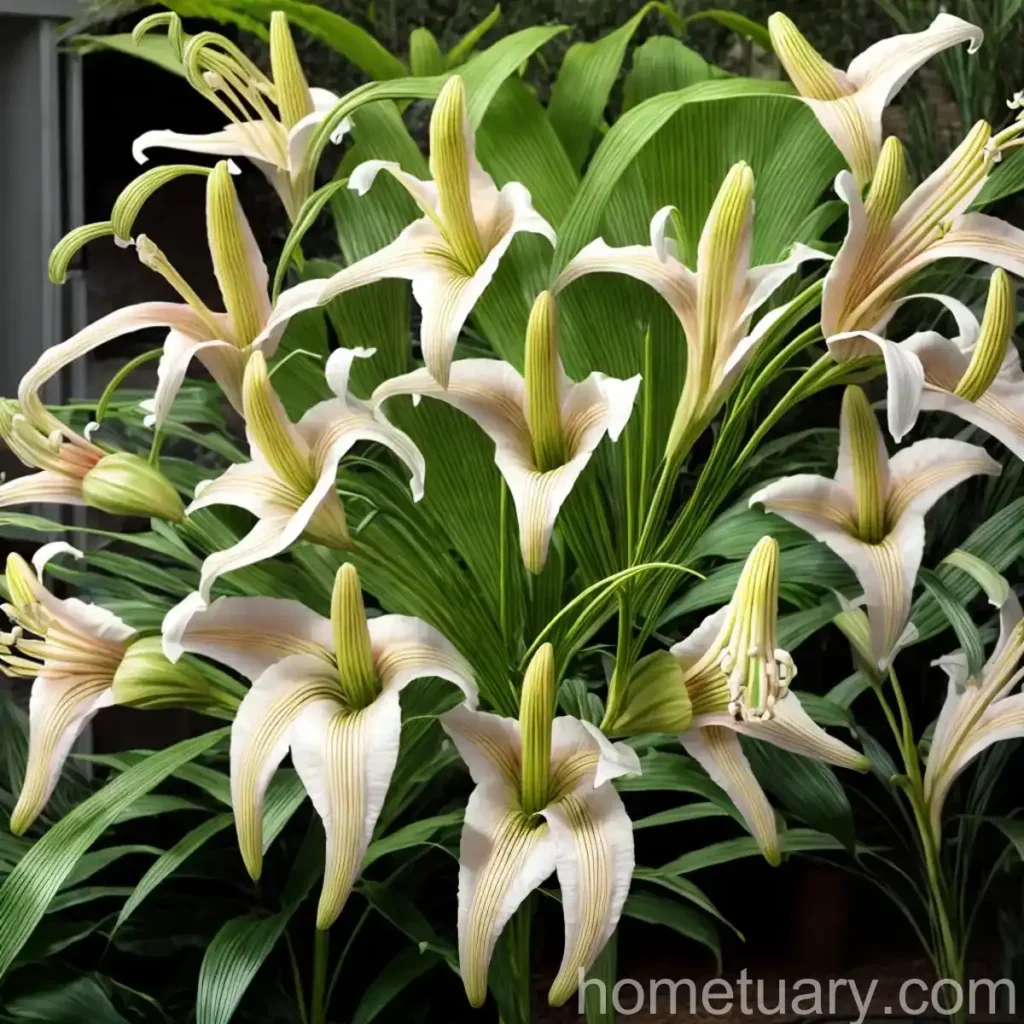Trumpet Lily (Lilium henryi): A Complete Guide
Plants have always held a special place in human society, not only for their aesthetic value but also for their cultural, medicinal, and ecological significance. The trumpet lily, scientifically known as Lilium henryi, is an exquisite flowering plant that belongs to the genus Lilium. In this extensive guide, we will delve into the various aspects of trumpet lilies – from cultivation and care to their ecological importance and cultural significance. Whether you are a seasoned gardener, a budding botanist, or simply someone who appreciates the beauty of nature, this guide aims to provide comprehensive insights into the world of trumpet lilies.
What is the Trumpet Lily (Lilium henryi)?
Lilium henryi, commonly referred to as the trumpet lily or Henry’s trumpet lily, is a species of flowering plant native to central and eastern Asia. It is a member of the Liliaceae family and is renowned for its striking trumpet-shaped blooms, which come in various shades of yellow, orange, and red. This species is known for its elegant appearance, captivating fragrance, and ornamental value, making it a popular choice for gardeners and florists alike.
Key Takeaways – Trumpet Lily (Lilium henryi)
Before delving into the specifics of trumpet lily cultivation and care, let’s highlight some key takeaways about this enchanting plant:
- Lilium henryi, also known as trumpet lily or Henry’s trumpet lily, is a species of flowering plant prized for its striking trumpet-shaped blooms.
- This species is native to central and eastern Asia and is known for its vibrant hues of yellow, orange, and red.
- Trumpet lilies are sought after for their ornamental value, fragrance, and suitability for both garden cultivation and floral arrangements.
With these key takeaways in mind, let’s explore the various aspects of trumpet lily cultivation, care, and its significance in horticulture and beyond.
Cultivation of Trumpet Lilies
The successful cultivation of trumpet lilies requires careful attention to their cultural requirements, including water, sunlight, fertilizer, and soil conditions. By understanding the fundamental needs of trumpet lilies, gardeners can create an environment that promotes healthy growth and abundant flowering.
Water
Proper watering is crucial for the well-being of trumpet lilies. These plants prefer consistently moist soil, especially during the growing season. However, it is essential to avoid waterlogging, as excessive moisture can lead to root rot and other detrimental conditions. A well-draining soil that retains moisture without becoming waterlogged is ideal for trumpet lilies. During dry spells, regular watering is necessary to maintain adequate soil moisture.
Sunlight
Trumpet lilies thrive in locations with ample sunlight. They require at least six hours of direct sunlight per day to ensure robust growth and prolific flowering. When selecting a planting site for trumpet lilies, it is important to prioritize areas that receive full to partial sun exposure. Adequate sunlight not only promotes flowering but also enhances the overall vigor and resilience of these plants.
Fertilizer
Proper nutrition is essential for the optimal development of trumpet lilies. Before planting, incorporating a balanced, slow-release fertilizer into the soil can provide essential nutrients that support healthy growth. Additionally, periodic fertilization during the growing season can further enhance the performance of trumpet lilies. A fertilizer with balanced NPK (nitrogen, phosphorus, and potassium) ratios, specifically formulated for flowering plants, can contribute to robust foliage and abundant blooms.
Soil
Trumpet lilies thrive in well-draining, fertile soil with a slightly acidic to neutral pH. Loamy or sandy loam soils with good aeration and moisture retention are well-suited for these plants. Amending the soil with organic matter, such as compost or well-rotted manure, can improve its texture and fertility, creating an optimal growing medium for trumpet lilies.
Pruning
Pruning plays a crucial role in maintaining the health and appearance of trumpet lilies. Deadheading spent blooms not only promotes continuous flowering but also prevents the plant from expending energy on seed production. In late fall or early spring, removing any dead or damaged foliage helps prevent disease and pest issues. However, it is important to avoid excessive pruning, as trumpet lilies benefit from the storage of nutrients in their bulbs for the following growing season.
Propagation of Trumpet Lilies
Propagation of trumpet lilies can be achieved through various methods, including bulb division and seed propagation. Both approaches offer distinct advantages and can be utilized to expand the population of these captivating plants.
Bulb Division
Bulb division is a common and effective method of propagating trumpet lilies. This process involves separating mature bulbs into smaller sections, each with a portion of the basal plate and surrounding scales. Spring or early fall is an ideal time for bulb division, as the plants are either emerging from dormancy or preparing for it. By replanting the divided bulbs at the appropriate depth and spacing, gardeners can establish new trumpet lily colonies and rejuvenate existing plantings.
Seed Propagation
While seed propagation of trumpet lilies requires more time and patience compared to bulb division, it offers an opportunity to introduce genetic diversity and potentially develop new cultivars. Collecting mature seeds from pollinated flowers and sowing them in a well-prepared seedbed can yield new trumpet lily seedlings. With proper care and favorable growing conditions, the resulting plants can mature into blooming specimens, showcasing a range of traits and characteristics.
Container Cultivation of Trumpet Lilies
For gardeners with limited space or those looking to showcase trumpet lilies on patios, balconies, or other confined areas, container cultivation offers a viable solution. When cultivating trumpet lilies in containers, several considerations, including pot size, soil mix, and maintenance practices, are essential for achieving successful outcomes.
Pot Size
Selecting an appropriately sized container is crucial for the healthy growth of trumpet lilies. A container with a diameter of at least 12 inches (30 cm) and a depth of 12-18 inches (30-45 cm) provides sufficient space for the development of trumpet lily bulbs and root systems. Furthermore, using containers with drainage holes facilitates proper water management, reducing the risk of waterlogged soil and associated issues.
Soil Mix
A well-draining, nutrient-rich potting mix is vital for container-grown trumpet lilies. A combination of high-quality potting soil, coarse sand, and organic matter, such as compost or peat moss, can create an optimal growing medium. This soil mix promotes adequate drainage and aeration, supporting healthy root development and overall plant vigor.
Watering and Maintenance
Container-grown trumpet lilies require regular watering to maintain consistent soil moisture. However, it is important to avoid overwatering, which can lead to root rot and other complications. Applying a balanced, water-soluble fertilizer at appropriate intervals ensures that the plants receive essential nutrients for sustained growth and flowering. Additionally, periodic inspection for pests and diseases, as well as deadheading spent blooms, contributes to the overall health and appearance of container-grown trumpet lilies.
Popularity of Trumpet Lilies
The allure of trumpet lilies extends beyond their captivating appearance, as they have gained popularity for various uses in horticulture, floristry, and cultural practices. From garden borders and landscape focal points to floral arrangements and symbolic meanings, trumpet lilies have secured a prominent position in the hearts of plant enthusiasts and beyond. Their popularity can be attributed to several factors, including their striking blooms, enchanting fragrance, and adaptability in diverse environments.
Garden Borders and Landscape Focal Points
In garden settings, trumpet lilies serve as eye-catching elements, whether planted in clusters or integrated into mixed borders. Their vibrant hues and towering stems add vertical interest and visual impact to flower beds and perennial borders. Furthermore, when strategically positioned as focal points within landscapes, trumpet lilies become focal points within the landscape, commanding attention and creating memorable visual experiences.
Floral Arrangements and Symbolic Meanings
The exquisite blooms of trumpet lilies are coveted by florists for use in various floral arrangements, including bouquets, centerpieces, and accent pieces. Their distinct shape and vibrant colors make them versatile additions to both formal and informal compositions. Additionally, trumpet lilies hold symbolic meanings in different cultures, often representing purity, renewal, and devotion. As a result, they are frequently incorporated into wedding bouquets and other ceremonial displays, adding layers of significance and emotional resonance to the floral designs.
Adaptability and Resilience
The adaptability and resilience of trumpet lilies contribute to their widespread popularity. These plants are capable of thriving in diverse climates and soil conditions, making them accessible to a broad spectrum of gardeners and landscapers. Their ability to naturalize in garden settings further enhances their appeal, as they establish sustainable populations and enrich the ecological fabric of their surroundings.
Common Diseases Affecting Trumpet Lilies
Despite their resilience, trumpet lilies are susceptible to certain diseases that can compromise their health and vitality. Understanding these common diseases and their associated symptoms is crucial for implementing timely management strategies and preserving the well-being of trumpet lilies.
Botrytis Blight (Gray Mold)
Botrytis blight, also known as gray mold, is a fungal disease that can affect trumpet lilies, particularly during periods of prolonged high humidity or wet conditions. Symptoms of botrytis blight include the development of grayish-brown mold on foliage, stems, and flowers, as well as the onset of necrotic lesions. To mitigate the impact of this disease, it is essential to promote adequate air circulation, avoid overhead watering, and apply fungicidal treatments when necessary.
Fusarium Wilt
Fusarium wilt is a soil-borne fungal disease that can affect trumpet lilies, leading to wilting, stunted growth, and discoloration of foliage. Infected plants may exhibit yellowing or browning of leaves, accompanied by a decline in overall vigor. Implementing proper soil sanitation and avoiding the introduction of contaminated planting material can help prevent the spread of fusarium wilt. Additionally, selecting resistant varieties and maintaining optimal growing conditions supports the long-term health of trumpet lilies.
Basal Rot
Basal rot, caused by various fungal pathogens, affects the basal plate and lower portions of trumpet lily bulbs, resulting in decay and the development of foul-smelling, mushy tissues. To minimize the risk of basal rot, it is crucial to ensure well-draining soil conditions, proper planting depth, and vigilant monitoring for signs of disease. Prompt removal and disposal of infected plant material, followed by thorough soil disinfection, can help mitigate the impact of basal rot and preserve the vitality of trumpet lilies.
Disease Diagnosis and Management
Diagnosing diseases affecting trumpet lilies involves careful observation of symptoms, followed by targeted management strategies that address the specific pathogens and their associated risks. By implementing integrated disease management approaches, gardeners can safeguard their trumpet lilies and cultivate thriving, disease-resistant plantings.
Symptom Recognition
Recognizing the symptoms of common diseases affecting trumpet lilies is essential for accurate diagnosis and management. This includes observing changes in leaf color and texture, evidence of mold or fungal growth, and unusual patterns of wilting or decay. By documenting and reporting observed symptoms, gardeners can facilitate effective disease diagnosis and treatment.
Disease Management Strategies
Implementing disease management strategies involves a combination of cultural, biological, and chemical measures aimed at reducing disease pressure and promoting plant health. Cultural practices, such as proper sanitation, crop rotation, and removal of infected plant material, play a pivotal role in disease prevention. Biological controls, including the introduction of beneficial microbes and organisms, can help suppress pathogenic activity. Additionally, targeted fungicidal treatments, applied in accordance with label instructions and recommended timing, offer an additional layer of defense against destructive diseases.
Common Pests that Affect Trumpet Lilies
In addition to diseases, trumpet lilies are vulnerable to infestations by common pests that can compromise their growth and flowering. Recognizing these pests and implementing appropriate pest management measures is essential for protecting trumpet lilies and maintaining their ornamental value.
Lily Leaf Beetles (Lilioceris lilii)
Lily leaf beetles are notorious pests that target trumpet lilies and related species, feeding on foliage and causing defoliation. These brightly colored beetles and their larvae pose a significant threat to the health of trumpet lilies, particularly during the growing season. Timely intervention, such as handpicking and disposal of beetles and larvae, can help alleviate pest pressure. Additionally, the application of insecticidal treatments targeting lily leaf beetles can aid in controlling infestations and safeguarding trumpet lilies from damage.
Aphids
Aphids are common sap-feeding insects that can infest trumpet lilies, leading to distorted growth and the transmission of viral diseases. These small, soft-bodied pests often congregate on the undersides of leaves and tender shoot tips, where they extract plant sap and excrete honeydew. Introducing natural predators, such as ladybugs and lacewings, can help manage aphid populations. When necessary, targeted applications of insecticidal soap or horticultural oil can provide additional control of aphids while minimizing impacts on beneficial insects and the environment.
Slugs and Snails
Slugs and snails pose a threat to trumpet lilies by feeding on foliage, stems, and flowers, resulting in unsightly damage. These mollusks are particularly active in moist environments and during periods of mild weather. Implementing physical barriers, such as copper tape or diatomaceous earth, can deter slugs and snails from reaching trumpet lilies. Furthermore, targeted trapping and removal methods, combined with judicious use of pet-safe slug and snail baits, can help manage these pests effectively.
Botanist’s Tips for Growing Trumpet Lilies
To guide gardeners in the successful cultivation of trumpet lilies, we present a collection of practical tips and recommendations from botanists and experienced horticulturists. These insights aim to enhance the understanding of trumpet lily care and empower individuals to create thriving and visually impactful plantings.
Tip 1: Selecting Healthy Bulbs
When purchasing trumpet lily bulbs, prioritize those that are firm, plump, and free from signs of damage or mold. Healthy bulbs serve as the foundation for robust and productive trumpet lilies, ensuring a strong start to the growing process.
Tip 2: Incorporating Organic Matter
Amending the soil with organic matter, such as compost or well-rotted manure, enriches the growing medium and promotes beneficial soil structure. Organic matter enhances soil fertility, moisture retention, and microbial activity, creating an optimal environment for trumpet lilies to flourish.
Tip 3: Mulching for Moisture Retention
Applying a layer of organic mulch around trumpet lilies helps conserve soil moisture, suppresses weed growth, and maintains a more stable root zone temperature. Mulching also contributes to the improvement of soil structure over time and provides a protective barrier against harsh weather conditions.
Tip 4: Regular Inspection for Pests and Diseases
Conducting routine inspections for signs of pests and diseases is vital for addressing issues in their early stages and preventing their escalation. Vigilant monitoring enables prompt intervention and minimizes the impact of potential threats on trumpet lilies.
Tip 5: Supporting Tall Stems
As trumpet lilies produce tall, majestic stems that may require support, consider providing stakes or rings to prevent bending or toppling. Proper stem support ensures that the blooms are showcased to their full advantage and minimizes the risk of breakage during inclement weather.
Tip 6: Assessing Sunlight Requirements
Carefully assess the sunlight requirements of trumpet lilies, aiming to provide at least six hours of direct sunlight per day. Understanding and meeting their sunlight needs contribute to robust growth, vibrant flowering, and overall plant vigor.
Fun Facts about Trumpet Lilies
Shedding light on the fascinating characteristics and historical significance of trumpet lilies, the following fun facts offer a glimpse into the captivating world of these iconic flowering plants.
- In traditional Chinese culture, trumpet lilies hold symbolic meanings of abundance, good fortune, and harmonious relationships. They are often featured in celebrations, art, and rituals, symbolizing prosperity and unity.
- The fragrance of trumpet lilies varies among different cultivars and species, ranging from subtle and sweet to intensely floral and captivating. Some varieties are sought after for their distinct aromas, which enhance their desirability in bouquets and gardens.
- As members of the Liliaceae family, trumpet lilies are botanically related to numerous ornamental and edible plants, including tulips, onions, and garlic. This diverse family showcases the broad spectrum of uses and habitats within the plant kingdom.
Links to External Resources
For additional information, inspiration, and practical guidance related to trumpet lilies, explore the following external resources:
- Royal Horticultural Society: Lilium
- American Lily Society
- University of Minnesota Extension: Growing Lilies
- The Spruce: How to Grow and Care for Trumpet Lily Plants
- Missouri Botanical Garden: Lilium henryi
Conclusion
In conclusion, trumpet lilies (Lilium henryi) stand as emblematic representatives of botanical beauty, cultural symbolism, and horticultural significance. Their enchanting trumpet-shaped blooms, vibrant color palette, and captivating fragrance captivate the senses and contribute to diverse applications in gardens, landscapes, and floral artistry. Understanding the nuanced requirements of trumpet lily cultivation, recognizing potential challenges, and appreciating their historical and cultural context enriches the experience of growing and appreciating these extraordinary plants. As proponents of sustainable gardening and biodiversity conservation, trumpet lilies offer a window into the intricate and awe-inspiring world of plant life, inviting us to acknowledge, protect, and celebrate the natural wonders that enrich our lives.















